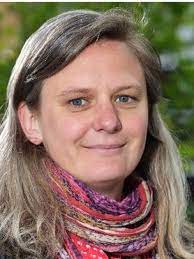Liedewij Laan
Liedewij Laan originally hoped that fundamental physics would help her understand everything, from elementary particles to human behaviour. She found her sweet spot in biophysics. ‘Molecules, energy, entropy – it is possible to capture life at the sub-cellular scale within the exact laws of nature.’
We want to unravel the adaptability of the cell, using a physics and chemistry perspective of molecules, their concentrations and interactions

Take a healthy yeast cell, induce a single mutation nearly paralyzing its ability to proliferate, let it evolve for a thousand generations, and those very handicapped cells will have perfectly adapted to being vital yeast cells again. ‘They will also look exactly like before,’ says Liedewij Laan, associate professor in the Department of Bionanoscience. ‘Under the hood, however, a handful more mutations occurred and nearly a thousand genes changed their importance and role for the cell’s proliferation.’ It’s like disabling a country’s electricity grid, after which its institutions, businesses, and citizens adapt their roles to somehow maintain production, communication and quality of life.
‘My goal is to unravel this robustness and adaptability of the cell at a very fundamental level, focussing on yeast as a model system,’ Liedewij says. On the one hand her group follows a bottom-up approach, using a purely physics and chemistry perspective (describing molecules, their concentrations and interactions) to build models from purified components that explain the cell’s adaptability. But they also use brute force – machine learning – to see whether, in hindsight, they could have predicted that the first mutation would lead to the subsequent mutations. ‘I prefer the bottom-up approach as it provides a real explanation,’ Liedewij says. ‘But machine learning is much faster in practice to find patterns.’
Cancer
Liedewij’s main drive is an almost unsatiable curiosity towards understanding (cellular) life. ‘I want to solve this biological puzzle,’ she says. ‘But I am also very much an engineer, who wants to solve real-world problems.’ A prime example of real-world consequences of genetic mutations is, of course, cancer – with a single onco-gene initiating a cascade of subsequent mutations and alterations making the cell very good at proliferating and, sometimes, much harder to kill.
‘I often think that my research is too fundamental but medical experts, such as oncologists and cancer biologists, are very enthusiastic whenever I present our approach and results,’ Liedewij says. ‘It helps them interpret cancer data, in pinpointing why various cancer cells appear to be so vastly different, and that this was perhaps triggered by only a few mutations.’ If the evolution of a cancer cell could be explained, the next natural question is how this can be prevented from happening. ‘Perhaps we can find a gene that doesn’t interfere with normal cell function and that, when mutated together with an oncogene, would induce cell death.’
Liedewij’s main drive is an almost unsatiable curiosity towards understanding (cellular) life. ‘I want to solve this biological puzzle,’ she says. ‘But I am also very much an engineer, who wants to solve real-world problems.’ A prime example of real-world consequences of genetic mutations is, of course, cancer – with a single onco-gene initiating a cascade of subsequent mutations and alterations making the cell very good at proliferating and, sometimes, much harder to kill.
‘I often think that my research is too fundamental but medical experts, such as oncologists and cancer biologists, are very enthusiastic whenever I present our approach and results,’ Liedewij says. ‘It helps them interpret cancer data, in pinpointing why various cancer cells appear to be so vastly different, and that this was perhaps triggered by only a few mutations.’ If the evolution of a cancer cell could be explained, the next natural question is how this can be prevented from happening. ‘Perhaps we can find a gene that doesn’t interfere with normal cell function and that, when mutated together with an oncogene, would induce cell death.’
Medical experts, such as oncologists and cancer biologists, are very enthusiastic about our fundamental research
Medical collaboration
Having investigated cell robustness at Harvard as a postdoc, Liedewij returned to the Netherlands to combine this biological evolutionary-genetics research with the biophysics of building a synthetic cell. ‘TU Delft has a very strong technological profile, promotes large multidisciplinary collaborations, and offers plenty of freedom to pick and expand your preferred research direction,’ she says. Thanks to the TU Delft Technology Fellowship she has established her own research lab, consisting of up to fifteen physicists, nanobiologists, chemists, and bio-informaticians.
Research funding agencies also value her research highly, considering she was already awarded several grants by the European Research Council (ERC) and NWO. And this November she will be interviewed for her ERC consolidator grant. ‘It has been a group effort to continually enhance our methodology and knowledge,’ she says. ‘And now the time is ripe for medical collaboration, to start translation and implementation.’
An amazing view
Scientific success and an expanding family have limited the time available to her for hobbies such as reading, soldering, and making music. But it is not all about science. ‘I love art, and I think it offers the quiet reflection needed for scientific inspiration,’ she says. If possible, she would love to resume rock climbing which, just like science, is about climbing a wall to reach an edge offering a fantastic view. ‘In my research, this would be a deep understanding of biological adaptability: that I can explain it to anyone in only four sentences, or with a single image.’